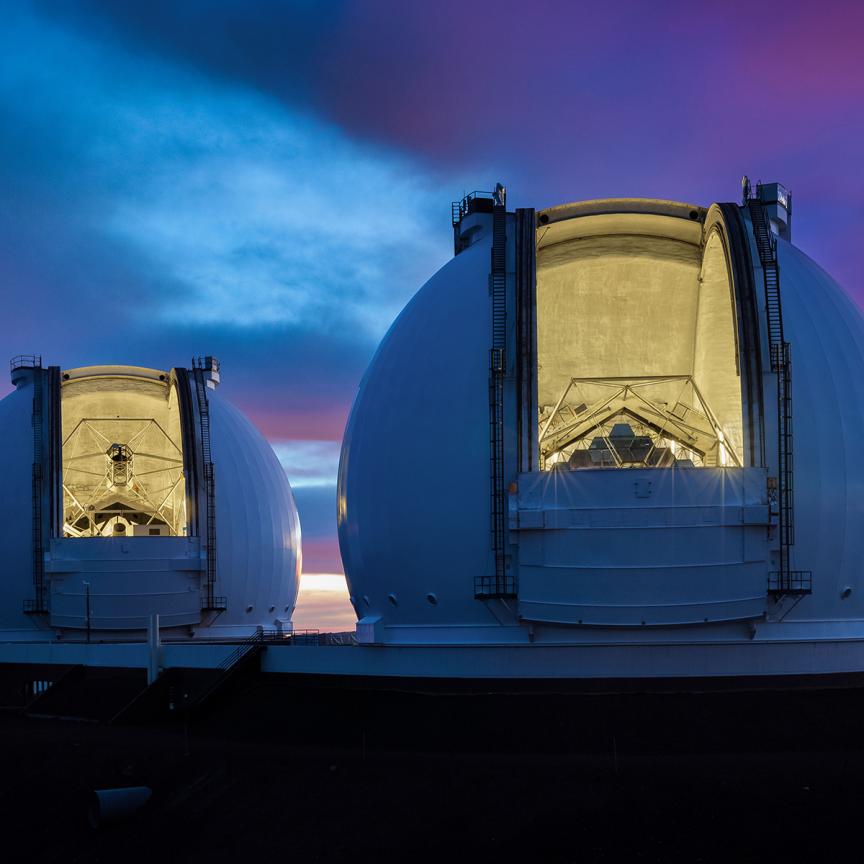Visible matter represents everything we can touch and see, yet it makes up less than five cent of the universe. The vast majority of the universe is dark, and does not emit or reflect – and cannot be detected with – light. The existence of dark matter has been inferred by astronomers as a result of the gravitational effects on visible matter, radiation and the structure in space, rather than it being observed through direct or indirect methods.
The first evidence for the existence of dark matter was produced in the 1930s, when astronomers observing the motion of galaxies found a discrepancy in their expectation that only accounted for matter that emitted light.
Observations of gravitational lensing have also pointed to matter additional to what is visible. Gravitational lensing, an effect related to Einstein’s general theory of relativity, causes gravity to bend the path of a beam of light in a particular way, meaning that a large object can distort the image of a distant light source in a manner similar to a magnifying glass. By comparing the known position of the source (obtained through direct emission of visible particles from the source) to its distorted image, the distribution of the matter causing the distortion can be reconstructed.
More recently, supercomputer simulations of the universe’s structure have shown that including only visible matter does not reproduce the structures observed in the universe – a closer agreement between observations and simulations is obtained only through including both visible and dark matter.
The presence of dark matter and its amount in the universe can also be inferred from the variations of temperature in the early universe. However, none of these observations provide a clear indication of what dark matter is made of.
Scientists around the globe hope to understand its nature by observing rare dark matter particles and their interactions from space, and by trying to produce them in controlled laboratory conditions.
Detecting in the lab
Scientists working with the Atlas detector at CERN’s Large Hadron Collider (LHC) are attempting to further understand the nature of dark matter by producing it in controlled laboratory conditions.
In March, CERN’s research board approved a new experiment designed to look for light and weakly interacting particles. FASER, or the Forward Search Experiment, will complement CERN’s ongoing physics programme, extending its discovery potential to several new particles associated with dark matter. Astrophysical evidence shows that dark matter makes up about 27 per cent of the universe, but it has never been observed and studied in a laboratory.

3D image of the planned FASER experiment in its tunnel. Credit: FASER/CERN
With an expanding interest in undiscovered particles, particularly long-lived particles and dark matter, new experiments have been proposed to expand the scientific potential of CERN’s accelerator complex and infrastructure as part of the Physics Beyond Collider (PBC) study, under whose aegis FASER operates. ‘This novel experiment helps diversify the physics programme of colliders, such as the LHC, and allows us to address unanswered questions in particle physics from a different perspective,’ explained Mike Lamont, co-coordinator of the PBC study group.
The four main LHC detectors are not suited for detecting the light and weakly interacting particles that might be produced parallel to the beam line. They may travel hundreds of metres without interacting with any material before transforming into known and detectable particles, such as electrons and positrons. The exotic particles would escape the existing detectors along the current beam lines and remain undetected. FASER will therefore be located along the beam trajectory 480 metres downstream from the interaction point in the Atlas detector. Although the protons in the particle beams will be bent by magnets around the LHC, the weakly-interacting particles will continue along a straight line and their ‘decay products’ can be spotted by FASER. The potential new particles would be collimated with the beam, spreading out very little, therefore allowing a relatively small and inexpensive detector to perform highly sensitive searches.
The detector’s total length is less than five metres and its core cylindrical structure has a radius of 10 centimetres. It will be installed in a side tunnel along an unused transfer line which links the LHC to its injector, the Super Proton Synchrotron.
FASER will search for a suite of hypothesised particles, including so-called ‘dark photons’, particles associated with dark matter. The experiment will be installed during the ongoing Long Shutdown 2 and start taking data from LHC’s Run 3 between 2021 and 2023.
‘It is very exciting to have FASER approved for installation at CERN. It is amazing how the collaboration has come together so quickly, and we are looking forward to recording our first data when the LHC starts up again in 2021,’ said Jamie Boyd, co-spokesperson of the FASER experiment.
‘FASER is a neat physics proposal that addresses a particular aspect in the search for physics beyond the standard model, and I am pleased to see it being implemented
so efficiently,’ added Eckhard Elsen, CERN’s director for research and computing.
Dark matter optics
Another area of experiment assumes that the elementary dark matter particles are very light bosons that collectively behave as a wave that self-interacts gravitationally. It is mathematically described with the so-called Schrödinger-Poisson equation (SPE, sometimes also called Schrödinger-Newton or Gross-Pitaevskii-Newton equation), a model introduced as a non-relativistic approximation to the dynamics self-gravitating scalar fields.
According to Humberto Michinel and Ángel Paredes at the Optics Laboratory of the University of Vigo in Ourense, Spain, this scenario provides an interesting opportunity for optics research.
Recently, a number of experiments have been performed to mimic aspects of Newtonian gravitation in non-linear optical setups, opening the possibility of designing optical analogues of gravitational phenomena, the researchers have said. Different versions of the non-linear Schrödinger equation, which are usually solved by means of computer simulations, are typically used for the description of laser light propagation in non-linear media. In particular, the SPE applies, among other situations, to the propagation of a laser beam in a thermo-optical material, namely one in which the refractive index depends on temperature. In this context, the Poisson equation appears naturally as a steady state heat equation.
Thus, the appearance of SPE in different frameworks is a mathematical coincidence that suggests that certain properties of dark matter behaviour should have an optical counterpart, Michinel and Paredes argue. For instance, solitons have been a subject of intense research during the past decades in the context of laser propagation in non-linear optical media. In an optical soliton, the interplay of diffraction, dispersion and non-linear optical properties of the materials gives rise to robust particle-like beams that can travel unlimited distances without any distortion in its shape. These ‘light bullets’ can also trap another light inside them, acting as light-guiding structures, yielding an ever increasing control on light propagation and to deep connections to other areas of physics, light fluid dynamics or cold atoms. Their cosmic equivalent would be the existence of huge self-trapped dark matter solitons that constitute the core of typical galaxies, with sizes in the hundreds or thousands of parsecs. In a sense, they act as waveguides for the galaxies that are trapped in the zone of highest gravitational attraction. This situation is analogous to all-optical soliton waveguides that are well known in non-linear optics.
It is also intriguing to consider soliton collisions from this point of view, noted Michinel and Paredes. In optics, researchers are acquainted with the fact that solitons behave like robust objects but that, when they meet, interference plays a decisive role. The same mechanism might therefore be at play in galactic collisions. Since dark matter solitons are coherent waves, they can interfere constructively or destructively like laser beams in an interferometer. In the case of solitons behaving like robust clumps, destructive interference is analogous to an elastic collision between two particles that separate after hitting each other. It is important to notice that the meticulous observations of galactic clusters stand out among the most promising strategies for understanding dark matter. The displacements of the stars, with respect to the gas and dark matter, give information about the dynamics of the collisions. Interferential optical-like phenomena might result in detectable features that, in fact, might have already been observed.
According to Michinel and Paredes, this ‘dark matter optics’ approach can be applied to the study of other cosmic phenomena, such as the coalescence of solitons in relation to galactic mergers or the interactions between dark matter and supermassive black holes, which can be easily modelled as ‘dot potentials’. Similarly, modulation instability and filamentation may provide an optical analogue of cosmic structure formation, they explained.
Conceptually, it is appealing that, albeit partially, the astrophysical and cosmological dynamics of dark matter can find an analogy in the spatial profiles of laser beams. Moreover, it is worth analysing this interdisciplinary connection, as usual notions or methods of optics might find application for dark matter or vice versa. ‘We hope this remarkable analogy will pave the way to performing tabletop photonics experiments that mimic particular aspects of the behaviour of dark matter in an optical laboratory,’ said Michinel and Paredes. EO

